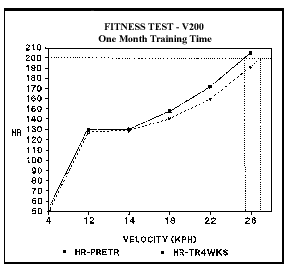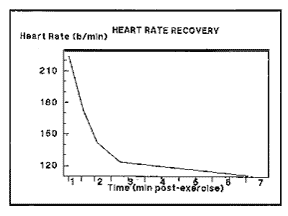Fitness On The Run
Fitness On The Run
by Gayle L. Ecker ERC Research Staff
Designing fitness tests in the field
The highly trained equine athlete of today must travel faster, higher, and further than before to remain competitive. Limited time is available to achieve training goals, yet the trainer must guard against causing "to far, to fast" injuries, thus delaying progress even more. So how do you determine when to safely advance to the next level of training?
Traditionally, we rely on subjective evaluations, or the "look" of the animal. Is the horse lean and tucked up? Does he seem to recover easily from the workout? New technology allows us to do some rather sophisticated tests to determine the performance level of the equine athlete today. However, not all trainers can afford these tests, or do not have access to testing facilities where high-speed treadmills are available for performance testing.
Basic equipment is all that is needed
The individual trainer can do a lot on their own with minimal equipment, such as a stethoscope and a stopwatch, that is affordable and likely to be in your stable already. Add a good surface for exercising your horse (you don't need a racetrack, an arena or large field will do), a clipboard to take notes, and you have what you need to get started to perform some simple, yet effective fitness tests for your horse.
Field Fitness Tests
With a little imagination you can custom design your own fitness tests. Once you have the basic equipment, just follow these guidelines:
- Try to design the test to reflect the specific demands of the event. If the horse is expected to sprint around barrels, a five mile endurance test may not be helpful.
- Make sure the test is repeatable. If conditions such as temperature or a new rider keep changing, you will not be able to make adequate comparisons between tests or between horses.
- Keep records of the conditions surrounding each test as well as the parameters measured, such as heart rate, respiratory rate, distance, speed, or body temperature.
Heart rate is a reliable measure
Heart rate is one of the most reliable indicators of fitness level and can be measured quiet easily using heart rate meters. Heart rate meters are very convenient to use and there are several affordable (about $400) and durable models available. The price range can vary as well as the options included for each type, so choose carefully the one that will fit your price range as well as your needs.
Although purchasing a meter is not necessary, they can be quite useful to monitor fitness and training results and the meter may work as an early warning system. If you notice changes in resting heart rates or erratic heart rate readings during the warm-up or the test, carefully check the horse as well as the electrodes.
Higher than normal or erratic heart rates may indicate an impending illness or lameness, or even fear.
Examples of fitness tests in the field
One example of a test that can be performed in the field is called a V200. This is a test designed to indicate the aerobic capacity of the horse and actually stands for the velocity which the horse maintains while the heart rate is 200 beats per minute. Heart rate is linear to the workload (the speed), and the more fit the horse, the higher the velocity for the given heart rate. An unfit or unhealthy animal will exhibit a lower velocity for the heart rate. If a heart rate meter is available, then this test can be carried out quite easily.
After a good warm-up, the horse is asked to accelerate at a controlled rate until the heart rate meter shows a heart rate of 200 beats per minute (bpm). The velocity of the horse can be determined by timing his speed over a known distance while the heart rate is kept at the 200 bpm level. The distance divided by the time will give you the velocity at a heart rate of 200 bpm. An alternative method would be to perform shorter distances at progressively increasing speeds while keeping track of the heart rate and the velocity. The heart rates can be plotted against the velocities and the line extended to extrapolate the velocity for the V200.

If the test is repeated at intervals, say every four weeks, improvements in the fitness of the horse and comparisons between horses can be made. If the horse is unfit, or you do not wish to push the horse to hard, you may modify the test to be a V160 instead.
A few words of caution are in order here. Keep in mind that a fitness test of this type reflects the changes in aerobic capacity of the horse. It does not reflect changes in the tendons, bones, and ligaments. Secondly, the conditions must be taken into consideration, for instance if the second test was performed under hot humid conditions, the V200 may be lower.
Proper warm-up essential
As with any type of activity that will stress the horse, a proper warm-up is essential to prevent injuries as well as allowing the systems to operate more efficiently. You will get more consistent test results if the warm-up is standardized.
Monitor recovery heart rate
The recovery time of the horse will reflect his training response. To monitor this, the horse should be exercised at a set speed for a set time and the heart rate monitored over the recovery period (at 1 minute post exercise, 5, 10 and 15 minutes). These results can be plotted on a graph and will show if the horse is able to recover faster from the work following a training program.
Be aware that the heart rate drops rapidly in the first two minutes following exercise. Therefore, if using a stethoscope, always take the heart rate at exactly the same time, e.g. one minute after the exercise, and for a maximum time of 15 seconds (# beats x 4 = bpm). Due to the drop, the heart rate you measure will be lower than the maximum reach during the exercise.

It is important to keep the area free from distractions and to keep the conditions the same to prevent variations in heart rates. It is best if the heart rate is kept between 150 to 210 bpm during the exercise since this range has the best reproducibility and is less sensitive to variations caused by distractions.
In summary: Experiment. Try out variations, following the above guidelines, and you will have more information about your horse, and your training methods. You will find it is easier to plan out your schedules for shows and competitions when you know what training advances can be expected.
The contents of this article are copyrighted but may be copied,
on condition that the Equine Research Centre be
acknowledged for the use of its information.

The Equine Research Centre
University of Guelph
Guelph, ON N1G 2W1
- Log in to post comments
